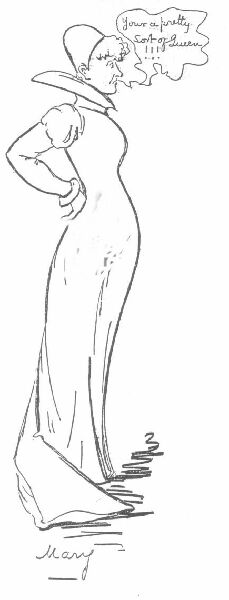
"Royal Court Theatre, Sloane-square, S.W., opposite the District Railway Station. Lessee and manager , Mr. Wilson Barrett. Engagement of Madame Helena Modjeska, who will appear each evening in an adaptation, by Hon. Lewis Wingfield, of Schiller's play, in five acts, entitled Mary Stuart. Scenery by William Beverly, Stafford Hall, and Walter Hann. Costumes

by Mons. Victor Barthe. Dresses worn by Madame Modjeska by Auguste &er; Co. Arms by Mons. Boursier. Furniture, fittings, and appointments by Mr. R.F. Brunton. Incidental music by Mr. James A. Brown.Chant in the last act by Mr. Robert Stoepel. The theatre has been re-decorated and
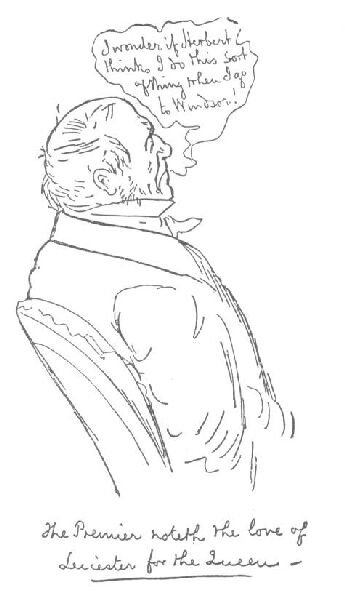
new smoking and refreshment rooms built by Messrs. White,Winter, and Co. The floral decorations byMr. William Maitland.Acting manager, Mr. H. Herman." Such is the front announcement (brave in old English characters and scarlet capitals) of the programme of the season at the Court Theatre. There is something comforting in learning the names of those to whom one is indebted for the details of a great performance. Mr. Barett has evidently done much to be evenly just in his acknowledgment of the assistance he has received. But human nature is a difficult thing to satisfy all round, and I must say on reading the above I began to wonder what the name of the neglected gasman might be, and whether the lady who received my overcoat was a Miss or Madame, and if the Commissionaire at the portals felt that his buttons had been polished in vain, since his name did not grace the programme. Odd bodkins and ruffles! but Master Wingfield has given us some English in his adaptation that is well worthy of the fine old Blackletter that announces the disposition of his characters on the bill of the play. On Saturday, when the Court Theatre re-opened its doors, a goodly audience presented itself, and although the rain poured in torrents, and although the St. James's Theatre induced the "first-nighters" with Mr. Wills's William and Susan, the house was crammed full. In the second row ofthe stalls was Mr. Gladstone, who had brought little herbert to see the play. I wonder if he would have left the boy at home of he had known of the conduct of Earl Leicester towards his sovereign liege, Queen Elizabeth? The front row was abandoned to the accommodation of a contingent of undulating AEsthetics, who in their sick invertebrate way curled and twined round one fair lily whio had given herself up to their attentions. These persons are becoming as affensive to the occupiers of the stalls a little further removed than the front row as the young men who know everybody on first nights and demonstrate from the front of the pit.
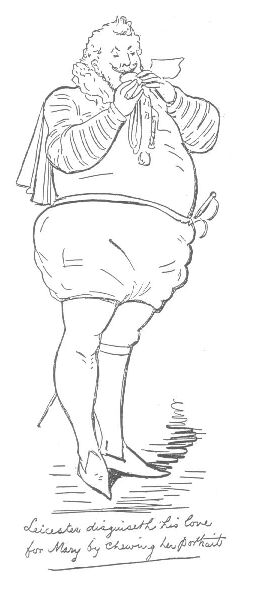
The gay and genial Boucicault and many other notables occupied other stalls, backed up by a bevy of fair damsels. From a side box Lord Barrington looked with smiling condescension uppon the Premier; opposite sat the pretty children of Mrs. Wilson Barrett, pleasingly interspersed with a mixture of the Bancroft family. But to the play. Mary Stuart, to begin with, had evidently contracted a cold in her dank cell; it may have been artistically correct, but it somewhat interfered with the dulcet tones of the Modjeska. The unfortunate Queen has not so much to do in Mr.Wingfield's adaptation as one would expect to find reserved for the bright particular star ofthe performance, and in this way Queen Elizabeth comes in for more opportunity - opportunity which Miss Louise Moodie - albeit she is a somewhat slangy Queen - seizes with full vigour and purpose. The Madame Angot scene between Mary and Elizabeth in Fotheringay Park, when they begin to say some nice things about each other's parentage and other little domestic trifles, and finally work themselves up into a double-barrelled fury, in which Mary scores one, is highly refreshing.
The play, masculinely considered, is divided into two factions: one consisting of old and young men, bent on assisting Mary; the other a scurvy set of villains, bent on the downthrow. The former are chiefly occupied in standing behind the latter and making pantomimic indications of their anxiety that the Queen should shut up, and thereby manage not to commit herself bythe use of her too ready,though pleasing, tongue. My Lord of Burleigh is her arch enemy, and Mr. Edwardprice made him a villain deep enough for more formidable purposes than the cutting off of a poor little head. The opposition old gentleman is played by Mr. J.D. Beveridge, whop presents George Talbot, Earl of Shrewsbury, to the audience as a nice milky old gentleman. There is also Sir Amias Paulet, admirably played by Mr. Clifford Cooper.This old gentleman is more ruled by a strict regard for his duty than aught else. There is one,Sir Edward Mortimer, played by Mr. J.R. Crauford, of George Barnwell memory. This young man is a strange youth, loving much the fair Queen, on account of having seen her portrait when her uncle was blessing him in Riome; if that portrait was one of the miniatures now extant, I can only say that Edward was an impressionable young man. As for the Earl of Leicester, it may be said that Mr. John Clayton, whatever else may be said of the love-sick nobleman
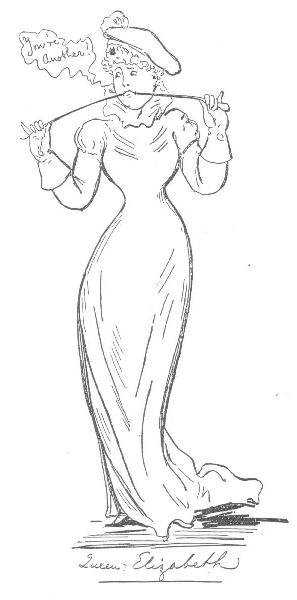
it cannot be asserted that he had wasted away through the non-success of his suit. Robust is he in body and in voice, evidently a man of large appetite, for when a portrait of his adored mary is given him he ravenously chews it as though it were a pastry maid-of honour
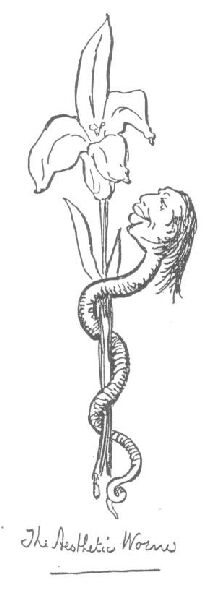
from Richmond instead of a Queen. Mr. John Clayton's ornamental love-making with Elizabeth was rather notable; when he lay at her feet and "dallied," his attempt to twist himself into graceful curves after the manner of the Vignette in the front of a drawing-room edition of "Kenilworth" was - Ah! Mr. Clayton, you must live on lilies and rosebuds, and take a few lessons from those long-haired young men in the stalls before you try that sort of thing. The most trying position into which the author has placed Leicester ios at the last act where he has to speak of a few particulars of Mary's execution to a group of the weeping faithful ones. he watches it by the aid of the keyhole, which she has just used to speak her last prayers to the audience through. This situation of Leicester's is highly inartistic, and considerably damaged the effect of the Queen's last moments upon the audience. Mary Stuart is exquisitely mounted in all appointments, and the scene of Fotheringay Park, by Beverly, is well worth seeing. The dresses are very fine, and happily correct.
Mary Stuart is preceded by Mr. H.A. Jones's pretty one act comedy of A Clerical Error, in which Mr. Wilson Barrett resumes his original part of the Rev. Richard Capel - which is a good picture of a fine, honest, good-hearted parson. M. Anson also plays his original part of the old wine-bibbing butler, Jeremiah Perry. It is time Mr. Jones's work began to see more of the light with managers; he must be highly capable of good comedy writing.